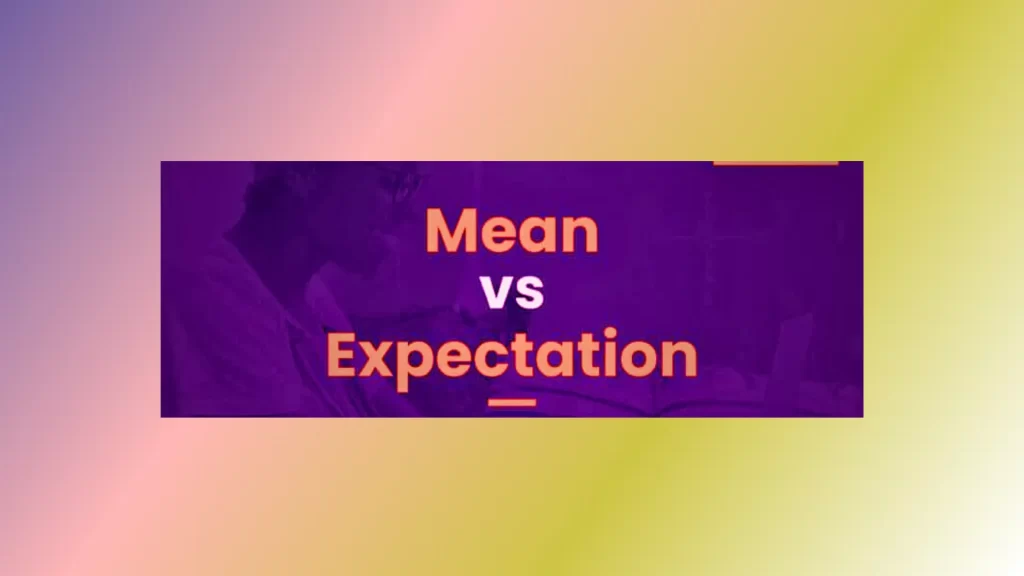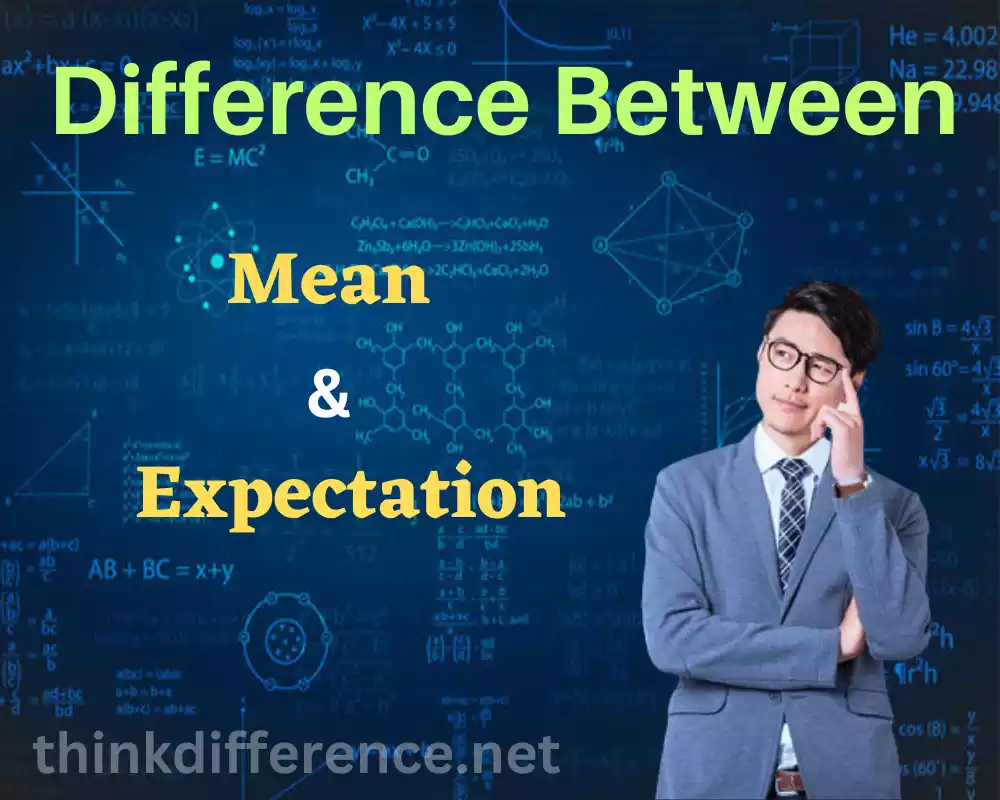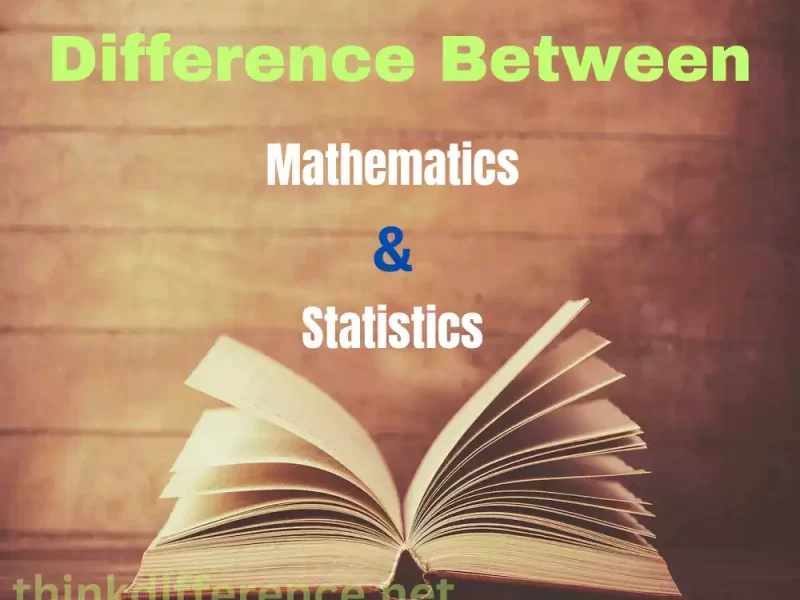Mean and Expectation hold significant importance. Mean and expectation provide insights into the central tendency of a dataset and help in making informed decisions. This article delves into the definitions, calculations, applications, and limitations of mean and expectation, shedding light on their significance in statistical analysis.
Definition of Mean
The average is a statistic used to measure central tendency within a group of values and is calculated by adding all values together and dividing that sum by its number of elements; similarly, its mean can also be computed this way.
A set with n numbers can be expressed mathematically as its mean:
Mean (m) = x1 + (x2 +(x3+…)+xn) /n
Where:
The mean is represented by an integer representing mean values; otherwise known as M (Mean).
Representing Individual Values From Dataset
n is used to represent the totality of values within an dataset.
The median is used to demonstrate central tendencies within data, as it represents “typical” values within it. It can help summarize and analyze information in fields as diverse as statistics, economics and science.
Definition of Expectation
Probability theory defines expectation as an expected value, or what can be anticipated with random variations. It is a measure of what one can expect to happen on average over repeated trials or observations.
Mathematically, the expectation of a random variable X is denoted as E(X) or E[x]. It is calculated by multiplying each possible value of X by its corresponding probability and summing up these products.
An expectation calculation for discrete random variables such as X can be performed as follows.
E(X), is defined by E = P(X =x1) +P(X=x2)+x3*P(X=x3) +…+ P(X=xn).
Where:
E(X) represents the expectation of the random variable X
x₁, x₂, x₃, …, xₙ represent the possible values of X
P(X = x₁), P(X = x₂), P(X = x₃), …, P(X = xₙ) represent the corresponding probabilities of each value occurring
For a continuous random variable, the expectation is calculated through integration using a probability density function (PDF).
The expectation provides a numerical summary of the random variable’s behavior, indicating the average outcome or value one can expect in the long run. Probability theory provides a foundation of statistical analyses, decision making processes and risk assessments. It has wide applications.
Importance of Mean and Expectation in Statistics

The mean and expectation play crucial roles in statistics, providing valuable insights and serving as fundamental measures for analyzing data and making inferences.
Here are some key reasons why the mean and expectation are important in statistics:
- Central Tendency: The mean represents the central tendency of a dataset, giving an indication of the typical or average value. It helps summarize the data by providing a single representative value that is easily understandable and interpretable.
- Descriptive Statistics: The mean is a commonly used descriptive statistic that provides a quick snapshot of the data distribution. It allows researchers and analysts to describe the dataset in a concise and meaningful way, facilitating comparisons and interpretations.
- Inferential Statistics: The mean plays a crucial role in inferential statistics. In hypothesis testing, the mean is often used to compare sample data to a hypothesized population mean, enabling researchers to assess whether observed differences are statistically significant.
- Estimation: The mean is used as an estimator to estimate the population mean based on sample data. By calculating the mean of a representative sample, statisticians can make inferences about the population mean and draw conclusions about the larger group.
- Probability Theory: Expectation is a fundamental concept in probability theory. It serves as a measure of the long-term average or anticipated value of a random variable. Expectation allows for quantifying uncertainty and making predictions based on probabilistic models.
- Decision-Making: Expectation is used in decision theory and utility theory to assess the expected outcomes of different actions or choices. By considering the expected values associated with various options, decision-makers can make rational and informed decisions under uncertainty.
- Statistical Modeling: Both the mean and expectation play vital roles in statistical modeling. They serve as parameters that characterize the behavior of a population or a random variable. In regression analysis, for instance, the mean or expected value of the dependent variable is modeled as a function of independent variables.
- Data Analysis and Interpretation: The mean and expectation provide valuable information for analyzing data, detecting patterns, and drawing conclusions. They help researchers understand the central tendencies, trends, and variations in the data, enabling them to make meaningful interpretations and draw valid conclusions.
The mean and expectation are fundamental statistical measures that allow researchers, analysts, and decision-makers to summarize, analyze, and interpret data, make inferences about populations, and quantify uncertainty. They serve as building blocks for various statistical techniques and play key roles in statistical modeling, hypothesis testing, and decision-making under uncertainty.
Applications of Mean and Expectation
The mean and expectation have wide-ranging applications in various fields due to their significance in summarizing data, making predictions, and assessing uncertainty.
Here are some key applications of the mean and expectation:
- Descriptive Statistics: The mean is commonly used as a descriptive measure to summarize data. It provides a representative value that gives an overall sense of the dataset. For example, in surveys or opinion polls, the mean can be used to determine the average response or opinion of the participants.
- Probability Theory: Expectation is a fundamental concept in probability theory. It is used to calculate the expected value of a random variable, representing the long-term average of its outcomes. Expectation plays a central role in analyzing and predicting outcomes in various probabilistic scenarios.
- Statistical Inference: Both the mean and expectation are used in statistical inference. In inferential statistics, the mean is often used to estimate population parameters based on sample data. This estimation helps make inferences about the larger population. Expectation plays a role in hypothesis testing, where the observed mean is compared to a hypothesized mean to assess the significance of results.
- Decision-Making: Expectation is crucial in decision theory and decision-making under uncertainty. It allows decision-makers to evaluate different options by considering the expected values associated with each option. By comparing the expected outcomes, decisions can be made based on rational assessments of potential risks and rewards.
- Financial Analysis: Mean and expectation are extensively used in financial analysis and investment decisions. Measures such as expected return and expected value are calculated to estimate the potential profitability of investments. These calculations help investors make informed decisions by considering the average returns and risks associated with different investment options.
- Risk Assessment: Expectation is utilized in risk assessment to quantify the potential losses or gains associated with uncertain events. By assigning probabilities to different outcomes and calculating their respective expected values, risk analysts can evaluate the overall risk exposure and make informed decisions to mitigate or manage risks.
- Machine Learning and Data Mining: Mean and expectation are frequently used in machine learning algorithms and data mining techniques. They serve as important statistical measures for data preprocessing, normalization, and feature engineering. The expectation is often used in probabilistic models and algorithms for prediction and classification tasks.
- Quality Control: The mean is employed in quality control processes to monitor and assess the consistency and accuracy of manufacturing or production processes. By calculating the mean of sample measurements, deviations from the target value can be identified, enabling adjustments or corrective actions to be taken.
These applications highlight the versatility and importance of the mean and expectation in various fields, including statistics, probability theory, decision-making, finance, and data analysis. Their ability to summarize data, predict outcomes, and assess uncertainty makes them fundamental tools for understanding and analyzing complex systems and processes.
Differences between Mean and Expectation
The mean and expectation are related concepts but differ in their applications, interpretations, and mathematical formulations.

Here are the key differences between the mean and expectation:
1. Conceptual Differences:
- Mean: The mean represents the average value of a dataset. It is a measure of central tendency, providing an indication of the typical value or the balancing point of the data distribution.
- Expectation: The expectation represents the long-term average or anticipated value of a random variable. It captures the average outcome or value one can expect over repeated trials or observations.
2. Applications:
- Mean: The mean is commonly used in descriptive statistics, inferential statistics, and data analysis to summarize data, compare groups, and make inferences about populations.
- Expectation: Expectation is primarily used in probability theory, decision-making under uncertainty, and statistical modeling to quantify uncertainty, predict outcomes, and evaluate choices.
3. Mathematical Formulation:
- Mean: The mean is calculated by summing up all the values in a dataset and dividing the sum by the total number of values. It is denoted by symbols such as μ (mu) or x̄ (x-bar).
- Expectation: The expectation is calculated by multiplying each possible value of a random variable by its corresponding probability and summing up these products. It is denoted by symbols such as E(X) or E[x].
4. Context:
- Mean: The mean is used when dealing with a dataset of observed values or a sample from a population. It is a measure of the central tendency of the data.
- Expectation: Expectation is used when dealing with probabilistic scenarios and random variables. It represents the average outcome or value expected from a random process or experiment.
5. Data Type:
- Mean: The mean can be calculated for both discrete and continuous data. It is applicable to numerical variables, such as heights, ages, or test scores.
- Expectation: Expectation is used for random variables, which can be discrete or continuous. It is applicable to variables with probabilistic behavior, such as coin tosses, dice rolls, or the outcome of an experiment.
6. Interpretation:
- Mean: The mean is interpreted as an actual value within the dataset. It represents the average value observed or measured.
- Expectation: The expectation is interpreted as a theoretical or expected value. It represents the average value anticipated or predicted over multiple trials or observations.
Although the mean and expectation share some similarities, such as representing averages, they have distinct contexts and calculations. The mean focuses on summarizing observed data, while the expectation deals with probabilistic outcomes and predicts long-term averages. Understanding these differences is important for correctly interpreting and applying these statistical concepts in various domains.
Common Misconceptions about Mean and Expectation
While the mean and expectation are important statistical concepts, there are several common misconceptions associated with them. Here are some misconceptions to be aware of:
1. Mean Represents a Typical Value for All Cases:
- Misconception: Many people assume that the mean represents a value that is present in the dataset or is representative of every individual case.
- Clarification: The mean represents an average value and may not necessarily correspond to an actual value in the dataset. It provides a measure of central tendency but may not capture the diversity or variability within the data.
2. Expectation Guarantees Actual Outcome in Every Trial:
- Misconception: Some individuals mistakenly believe that the expectation of a random variable guarantees that the observed outcome will match the expected value in every trial or experiment.
- Clarification: Expectation represents the long-term average or anticipated value over repeated trials. While the expected value provides a prediction, individual outcomes may differ from the expected value in any given trial due to randomness or variability.
3. Mean and Expectation Are Always the Same:
- Misconception: There is a common misconception that the mean and expectation are always equivalent and can be used interchangeably.
- Clarification: While the mean and expectation share similarities as measures of average values, they are not always the same. The mean is calculated based on observed data, while the expectation involves probabilities and applies to random variables.
4. Mean or Expectation Alone Fully Describes the Data:
- Misconception: Some individuals believe that knowing the mean or expectation alone is sufficient to fully describe or summarize a dataset or random variable.
- Clarification: The mean or expectation provides valuable information about central tendency and anticipated values, but it does not capture the full range of information about the data or random variable. Additional statistical measures and analysis are often required to gain a comprehensive understanding.
5. Outliers Have No Influence on Mean or Expectation:
- Misconception: It is a misconception that outliers or extreme values have no impact on the mean or expectation.
- Clarification: Outliers can significantly influence the mean as it is sensitive to extreme values. The expectation can also be affected by outliers, especially if they have non-negligible probabilities. Therefore, outliers should be carefully considered and evaluated when interpreting the mean or expectation.
6. Mean or Expectation Alone Determines Data Distribution:
- Misconception: Some people assume that knowing the mean or expectation is sufficient to determine the entire distribution or shape of the dataset or random variable.
- Clarification: The mean or expectation provides information about the central tendency, but it does not determine the complete distribution. Other statistical measures, such as variance, skewness, or higher moments, are required to fully characterize the data distribution.
It is important to be aware of these misconceptions to avoid misunderstandings and ensure accurate interpretation and application of the mean and expectation in statistical analysis.
Variants of Mean and Expectation
There are several variants and related concepts that are derived from or closely related to the mean and expectation.
Here are some common variants:
1. Variants of Mean:
- Arithmetic Mean: A common variant of mean is an arithmetic mean or average. Calculated by adding all values together and dividing by their count.
- Weighted Mean: In a weighted mean, each value in the dataset is assigned a weight before calculating the mean. The weight represents the relative importance or contribution of each value to the overall mean.
- Geometric Mean: The geometric mean is a variant used for data that follows exponential or multiplicative growth patterns. Calculated by taking the nth roots of the product of values where n is equal to total number of values.
- Harmonic Mean: The harmonic mean is often used for rates or ratios. It is calculated by taking the reciprocal of the arithmetic mean of the reciprocals of the values in the dataset.
2. Variants of Expectation:
- Conditional Expectation: Conditional expectation refers to the expected value of a random variable given certain conditions or events. It is calculated by integrating or summing the conditional probabilities of the variable’s values multiplied by those values.
- Expected Utility: Expected utility is a concept used in decision theory to assess choices involving uncertain outcomes. It incorporates the concept of expectation with utility, representing the average utility or value expected from different decision options.
- Expectation of a Function: In some cases, the expectation is taken of a function of a random variable rather than the variable itself. This involves applying the function to each possible value of the random variable, weighting it by the corresponding probabilities, and summing or integrating the results.
- Higher Moments: In addition to the mean, moments are statistical measures related to the expected values of powers of a random variable. Higher moments, such as variance (second moment) and skewness (third moment), provide additional insights into the distribution and shape of the data.
These variants and related concepts expand upon the basic notions of mean and expectation, allowing for more nuanced analysis and modeling in different contexts and scenarios. Understanding these variants can provide a broader toolkit for statistical analysis and decision-making.
Examples Illustrating Mean and Expectation
Here are some examples that illustrate the concepts of mean and expectation:
Example 1: Rolling a Fair Six-Sided Die Suppose you have a fair six-sided die, and you want to calculate the mean and expectation of the outcomes.
- Mean: The mean represents the average value of the outcomes. For a fair die, the possible outcomes are 1, 2, 3, 4, 5, and 6, each with equal probability (1/6). The mean is calculated as: Mean = (1 + 2 + 3 + 4 + 5 + 6) / 6 = 21 / 6 = 3.5
- Expectation: The expectation represents the expected value of a random variable. In this case, the random variable is the outcome of rolling the die. The expectation is calculated as: Expectation = (1 * 1/6) + (2 * 1/6) + (3 * 1/6) + (4 * 1/6) + (5 * 1/6) + (6 * 1/6) = 3.5
In this example, both the mean and expectation are equal to 3.5, indicating that on average, the outcome of rolling the fair die will be 3.5.
Example 2: Exam Scores Consider a class of students who took an exam, and their scores are as follows: 75, 80, 85, 90, 95.
- Mean: The mean represents the average score of the students. The mean is calculated as: Mean = (75 + 80 + 85 + 90 + 95) / 5 = 425 / 5 = 85
- Expectation: Suppose each student’s score is treated as a random variable, and the expectation is calculated based on the probability distribution of the scores. Assuming each score has the same probability, the expectation is calculated as: Expectation = (75 * 1/5) + (80 * 1/5) + (85 * 1/5) + (90 * 1/5) + (95 * 1/5) = 85
In this example, both the mean and expectation are equal to 85, indicating that, on average, the students’ scores are 85.
These examples demonstrate how mean and expectation are calculated and how they represent the average values in different contexts. While the examples provide simple illustrations, the concepts of mean and expectation can be applied to more complex scenarios and larger datasets to gain insights and make informed decisions.
Factors Affecting Mean and Expectation
The mean and expectation of a dataset or random variable can be influenced by several factors.
Here are some key factors that can affect the mean and expectation:
- Data Values: The specific values in the dataset or the range of values a random variable can take have a direct impact on the mean and expectation. Outliers or extreme values can significantly affect the overall average, pulling it towards higher or lower values.
- Data Distribution: The distribution of data or the probability distribution of a random variable plays a crucial role. Different distributions, such as normal, uniform, or skewed distributions, can lead to different mean and expectation values.
- Sample Size: Size can make an important difference to accuracy and reliability of data collected for research studies. Generally, larger sample sizes tend to provide more reliable estimates of the population mean.
- Weighting: If certain values in the dataset or outcomes of a random variable are given more weight or importance, it can affect the mean and expectation. Weighted means and conditional expectations consider the relative importance or probabilities assigned to each value or outcome.
- Missing Data: Missing or incomplete data can impact the calculation of the mean and expectation. Depending on the missing data pattern, the mean and expectation may need to be estimated or adjusted using appropriate imputation techniques.
- Transformation: Applying mathematical transformations to the data can alter the mean and expectation. Transformations such as logarithmic, exponential, or power transformations can change the distribution and subsequently affect the mean and expectation values.
- Sampling Bias: If the data or observations are collected in a biased manner, it can introduce sampling bias and potentially affect the mean and expectation. Biased sampling methods may lead to an over- or underestimation of the true mean or expectation.
- Changes over Time: For datasets or random variables that are time-dependent, changes in the underlying process or distribution over time can impact the mean and expectation. The mean and expectation may vary across different time periods or subsets of data.
It’s important to consider these factors when interpreting or analyzing the mean and expectation values. Being aware of the potential influences can help ensure the accuracy and validity of statistical analysis and decision-making processes.
Limitations of Mean and Expectation
While the mean and expectation are widely used statistical measures, they have certain limitations that should be considered when interpreting and using them.

Here are some key limitations:
- Sensitivity to Outliers: The mean and expectation are sensitive to outliers or extreme values in the dataset. Outliers can disproportionately influence these measures, causing them to be skewed or unrepresentative of the majority of the data. It is important to be cautious when interpreting the mean or expectation in the presence of outliers.
- Distributional Assumptions: The mean and expectation assume that the data or random variable follows a specific distribution. In many real-world scenarios, the underlying distribution may not be known or may deviate from the assumed distribution. Relying solely on the mean or expectation may not capture the full complexity of the data or provide accurate estimates.
- Non-Robustness to Skewed or Non-Normal Data: The mean and expectation are not robust measures when dealing with skewed or non-normal distributions. Skewed data can result in biased estimates of the mean and expectation. In such cases, alternative measures like the median or trimmed mean may be more appropriate.
- Inadequate for Describing Complex Data Patterns: The mean and expectation provide a summary measure but may not capture the full complexity of the data. They do not provide information about the shape of the distribution, presence of multimodality, or other higher-order characteristics. Additional statistical measures and techniques are needed to gain a more comprehensive understanding of the data.
- Inability to Account for Uncertainty: The mean and expectation do not explicitly incorporate measures of uncertainty or variability. They provide point estimates without indicating the range or spread of the data. Confidence intervals, standard deviation, or other measures are necessary to quantify and communicate the uncertainty associated with the estimates.
- Dependence on Sample Size: The accuracy and reliability of the mean and expectation estimates depend on the sample size. Smaller sample sizes can lead to higher sampling variability and less precise estimates. When interpreting results and establishing confidence levels in estimates, it is crucial to take the sample size into consideration.
- Disregard for Temporal or Contextual Information: The mean and expectation treat all data points or outcomes as equally important, regardless of their temporal order or context. They do not consider dependencies, trends, or changes over time, which may be relevant in certain applications. Time series analysis and other techniques are required to account for such factors.
- Limited Usefulness for Categorical or Qualitative Data: The mean and expectation are primarily applicable to numerical data or random variables. They are not directly applicable to categorical or qualitative variables, where alternative measures like mode or frequency distributions are more appropriate.
Understanding the limitations of the mean and expectation helps to ensure their appropriate use and interpretation. When selecting statistical measures to analyze data, it’s crucial that they take into account both its characteristics and distribution patterns.
Summary
Mean and Expectation are foundational concepts in statistical analysis, empowering researchers, analysts, and decision-makers to unravel the patterns hidden within data. Their applications span across diverse industries, making them indispensable tools for making sense of the world’s complexities.



